When you are growing microgreens, whether it’s for personal or commercial use, it’s important to keep your trays clean, and sanitized. Removing soil and other residues from your growth, such as roots and dead plants, will protect against potentially harmful germs, fungus, and damping off.
If you want to have strong and healthy microgreens, you have to handle your trays and other equipment with care.
In this article, we will guide you through a simple but yet effective 4-step process to clean and sanitize your trays as a home grower.
- Remove leftover debris with a dry scrub
- Clean with soap & rinse with water
- Sanitization
- Let them dry
If you are growing commercially, you can apply the same approach, but be mindful that depending on your country and even region/state, you may have to adhere to different local sanitization guidelines.
Before we jump into explaining the steps, let us first understand the importance of cleaning and the various sanitizing solutions you can use.
Why do you need to sanitize your trays?
To clean and sanitizes your trays before you start growing your next batch of microgreens is essential. It can be tempting to take the easy way and only clean your trays with soap and water. However, this won’t kill all germs. Just the same, to only use disinfectants don’t remove stains and soils. They work on clean surfaces, so you need to do both!
Sanitation is an easy way to prevent seedling blight* and other diseases such as fungus and mold. There are probably many people who believe that these diseases are associated merely with dirty and unsterilized soil. However, lack of cleaning and not disinfecting your equipment can contribute to plant failure. If you leave your trays with residual roots, plants, and medium, it can get stuck in your trays. This leftover dirt can harbor bacteria, and over time that can cause fungus to grow.
The effort that it takes to keep your trays clean is small compared to facing a disease that causes your microgreens to fail. Taking good care of your trays will also make them last longer.
* Seedling blight is a fungal infection that causes seed to rot and not emerge but rather wilt, become brown and die.
What are the best ways to sterilize microgreen trays?
There are numerous products & solutions available when it comes to cleaning and sanitizing products for seed and planting trays.
You can use boiling water, chemicals such as bleach or hydrogen peroxide, or you can make your own solution using household products.
Using hot water
The simplest solution is using plain boiling water, but it will not provide 100% sterilization. You can clean them using water only, but you may not get rid of all bacteria.
To ensure that you kill any pathogens using boiled water, it must 212° Fahrenheit (100° Celsius). The challenge, however, of using hot water is that you should place your entire tray in the boiling water for one to five minutes. So, if you are planning on using boiling water for sterilization for larger trays and containers, it is probably not your best choice.
Use vinegar
You can also make a home-made solution by mixing an equal part of white vinegar and water into a spray bottle. Vinegar is a strong acid that kills most germs.
Using a solution that you have made yourself from everyday kitchen ingredients will be less expensive and non-toxic solution alternatives to harsh chemical products. Just remember that this solution may not provide 100% sterilization.
As with any other product, always test on a small area before you use the solution on your tray.
Using hydrogen peroxide
Using hydrogen peroxide (aka H2O2) is a commonly used product for sanitizing microgreen trays. It is far less harsh, and it is more environmentally friendly than chlorine bleach (see next).
Hydrogen peroxide is seen as an environmentally safe alternative to chlorine-based bleaches, as it degrades to form oxygen and water and it is generally recognized as safe as an antimicrobial agent by the U.S. Food and Drug Administration (FDA).[71] – Source Wikipedia
It is a great product not only for sterilizing your trays but it has several advantages:
- Antibacterial – it kills bacteria cells
- Anti-fungal – it treats fungal growth
- Kills mold & mildew – It kills mold and mildew and prevents damping off
When using the product for sanitizing trays, you should apply the ordinary hydrogen peroxide at a strength of 3%. For consumers, it is usually available from pharmacies, your local grocery store, hardware stores, or online.
Even though hydrogen peroxide is friendly to use for sterilizing your microgreens trays, you still need to handle it with care.
Some things to take into account are:
- Never place the product near a heat source or any flammable liquids or equipment.
- Store it out of reach from children and animals.
- Store it in a dark place as it degrades more quickly when exposed to light.
- It can irritate your skin, so always wear gloves when using the solution.
- Be cautious not to get the hydrogen peroxide in your eyes and always consult with a medical facility should that happen.
Using bleach
A common approach to disinfect or sterilize trays is using chlorine bleach. It’s a chemical that is harsher than using any of the other solutions described. Using bleach is effective for killing bacteria, but you should be aware of its ingredients and be careful when using it. On the EWG Website, it is rated an F due to its toxic ingredients.
There are different types of household bleach, the chlorine bleach, and as earlier mentioned the hydrogen peroxide. You should always learn about the product and its impact before using it.
“The two types of household bleach are chlorine bleach and peroxide bleach. [… ] Peroxide bleach does not disinfect and is commonly added to laundry detergents which are advertised as color-safe. […] The more common form of household bleach in the U.S. is chlorine bleach. It is most effective in removing stains and disinfecting fabrics.” – Source Encyclopedia
Source: Encyclopedia
To use the chlorine bleach solution, you should mix 1-part bleach to 9 parts water to disinfect your trays, and soaking them for 15-20 min. You should not use the solution in its concentrated form.
Same as using any other chemicals, you must be conscious of how you apply it.
Bleach is a chemical irritant, and in its concentrated form, it can damage skin, eyes, and clothing. It is also bad for sanitizing some surfaces.
Some things to take into account are:
- Never place the product near a heat source or any flammable liquids or equipment.
- Never combine bleach with other products, especially ammonia. It can produce harmful and potentially lethal fumes.
- Store it out of reach from children and animals.
- Store it in a dark place as it degrades more quickly when it is exposed to light.
- It can irritate your skin, so always wear gloves when using bleach.
- Always be cautious where you are using the solution as it can damage and discolor surfaces made of wood, metals, and granite.
- Be cautious about not getting the solution in your eyes and always consult with a medical facility should that happen.
Remember that whatever solution you decide to use, any chemicals aimed to help with the cleaning process, you must always follow label directions.
How to clean & sanitize your trays
Let us now take you through the 4-step process to clean and sanitize your microgreen trays.
A good practice is to clean your equipment as soon as possible after harvest, to avoid dirt from setting in. If you leave the medium and growth leftovers, they will dry in and it can be difficult to remove. It will be even more noticeable if you are using trays with drainage holes.
1. Give them a dry scrub
The first thing to do is to give your trays a dry scrub to remove any remaining matter from your last growth. Use a dry brush, scrub brush, or cloth and wipe them clean from any soil or other medium, roots, or discarded microgreens. Check the underside of your trays as well and scrap out any roots if there are any stuck in the drainage holes.
You can throw any residues into your compost, and if you don’t have one, you can dispose of it in the garbage.
If you have many trays that need cleaning, a different way to wipe them clean is to lay them all on the ground and use a broom.
You should always clean your trays before you start with the sanitation. Germs can hide underneath dirt and other material on surfaces where they are not affected by the disinfectant.
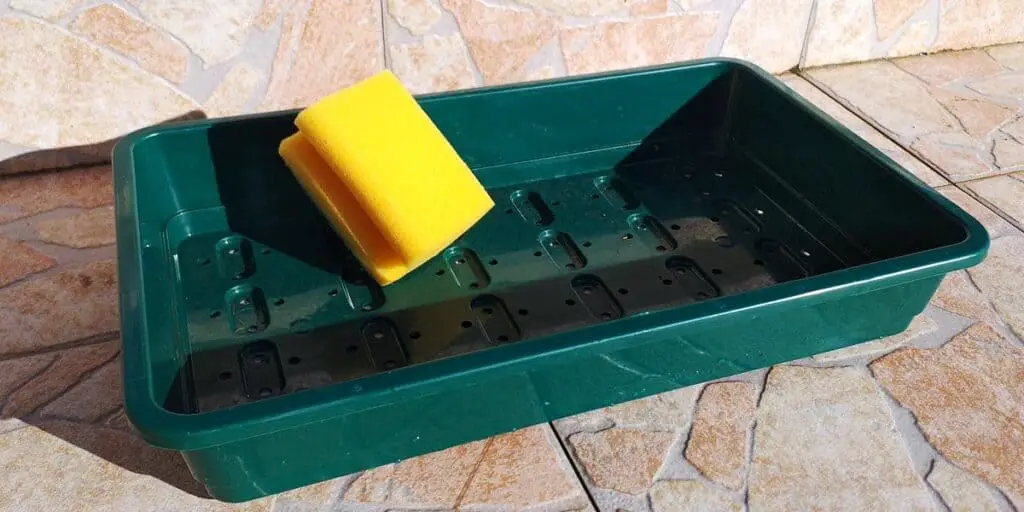
2. Rinse with water
Once your tray is clear from any residue material, clean them with soapy water and rinse them. If you are cleaning a single tray, place it under your tap and give it a good rinse. If you have several trays and you have access to an outdoor space or garden, then you can rinse them with a hose. You will add some more pressure, and you can easier remove any remaining dirt.
If you have a power washer, you can use this one to clean your trays. Just remember that there is a lot of pressure in this machine, and you should be conscious of how and where you place your trays. This method is more commonly used if you are working with many trays.
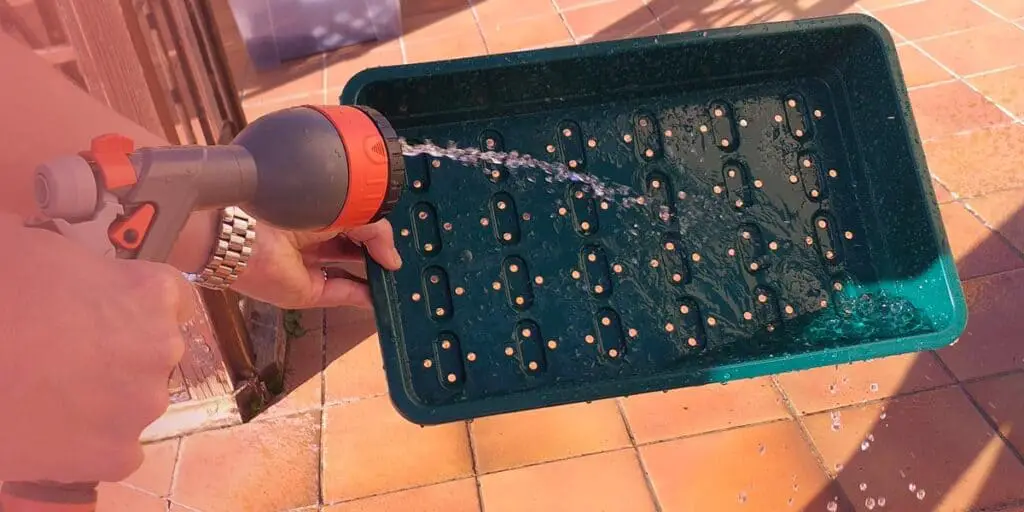
3. Sanitation
When the trays are rinsed and clean, it is time to sanitize. As mentioned, there are different solutions you can use, and if you have chosen to use either a home-made vinegar mix, hydrogen peroxide, or bleach, you can apply the same techniques. If you only want to clean with boiled water, this next step is not needed.
Spray your trays
No matter what solution, you can use a spray bottle to soak your trays. Fill up the bottle with the mixture of your choice (home-made vinegar/water, hydrogen peroxide, or bleach). Spray the solution on the trays and leave for some time.
Always check the product label to ensure that you are applying the correct amount of time for the product to work. Once you are done, rinse the solution of the trays.
Regardless of which sanitizer you choose, remember that good sanitation is not only determined by the type of sanitizer that you use but also in the way you use it. The time needed for the solution to work is relevant. Always remember to follow the instructions on the bottle to know how long it needs to stay in contact with the surface.
Dip your trays
Instead of using a spray bottle, you can also fill up a washing bin, bucket, or another large container with your sanitizing solution. Put the trays in and leave to soak. The same time applies as provided above.
If the tray could not be fully covered, you should flip it over to ensure the entire tray gets sanitized.
Using this approach can be beneficial if you have many trays to clean at the same time.
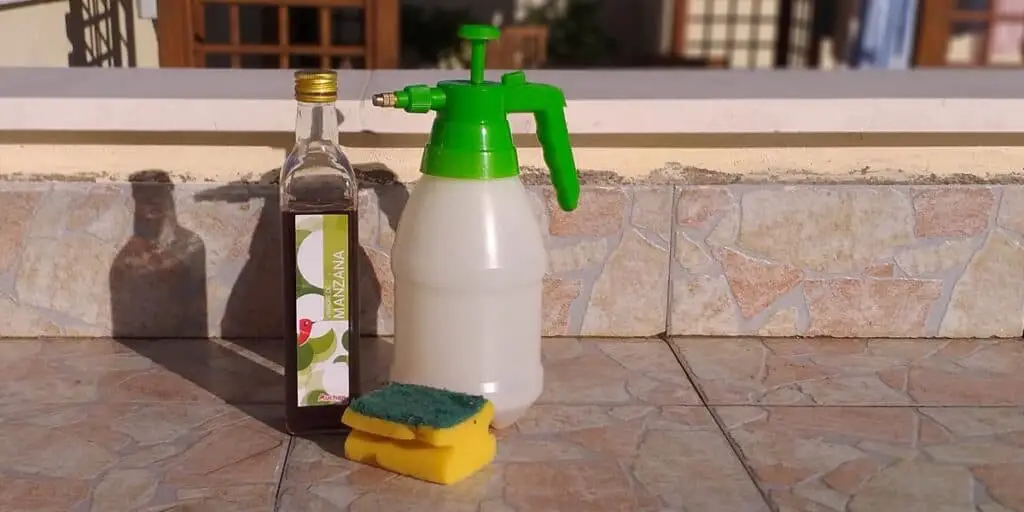
4. Dry
The last step in the process is to dry the tray(s). Let them air dry or wipe them dry with a kitchen towel or towel paper. Once they are dry, you have your sanitized trays redo for your next growth!
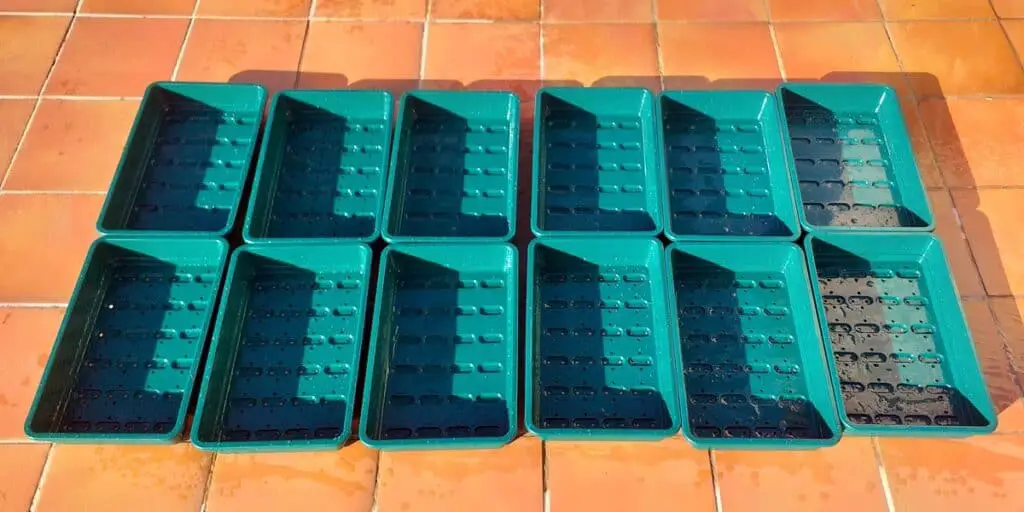
Can you reuse any trays?
As we have gone through the simple process of keeping your trays clean, you may wonder if all types of trays can be cleaned and reused. The answer is yes if you are using proper microgreen and seedling trays and no if you are using single-use plastic containers.
Our recommendation is using sturdy and reusable plastic trays designed for growing microgreens over single-use plastic ones. It is more environmentally friendly as you will not contribute to polluting our seas and landfills with plastic waste, they will last you longer, and importantly, safer to use.
To use single-use plastic can be risky if you do not know what the plastic the container is made of. If it is intended for one-time use, it may not be designed for easy cleaning.
In terms of chemical leaching, plastic containers with the recycling code 2 (high-density polyethylene, HDPE), 4 (low-density polyethylene, LDPE) or 5 (polypropylene, PP) are safest for reuse, says Daniel Schmitt, associate professor of plastics engineering at the University of Massachusetts Lowell, U.S.
These materials typically do not contain plasticizers that could leach into food when the container is heated in the microwave, washed in the dishwasher or left in the sun for a long time. Plastic containers with recycling codes 1 (polyethylene terephthalate, PET), 3 (polyvinyl chloride, PVC), 6 (polystyrene, PS) and 7 (all other plastics such as polycarbonate, PC) are more prone to chemical leaching and less suitable for reuse, Schmitt explains. – Source Food Packaging Forum
Overall, it is safer to use trays designed to grow microgreens. Avoid using any single-use plastic containers you may have brought home when buying groceries and polystyrene (foam) containers, for example, used for taking away coffees & food.
READ ALSO: The Best Microgreens Trays
Final words
Keeping your trays and other equipment clean and sanitized is important as you are dealing with edibles. It may be tempting to skip some of the steps and simply rinse those trays, but you may end up having to face your microgreens failing and suffering mold and other germs.
If you are having difficulties getting your microgreens to grow healthy, a bad habit of not cleaning and sanitizing your trays can be the cause.
To apply a good routine of cleaning and using proper sanitizers will result in healthier growing microgreens and ensure you get the most out of your growth (an investment!)


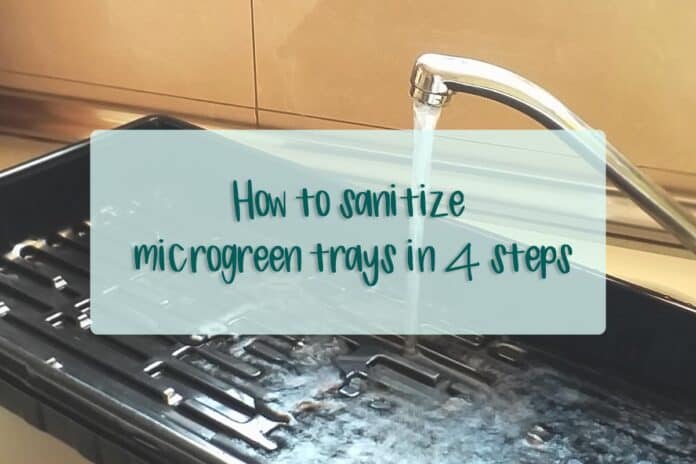
RE: Sanitizing micrgogreen trays – “DIP YOUR TRAYS”
I’d like to use the “dip your trays” approach with grocery store gallon jug chlorine free bleach (3-4% hydrogen peroxide). Do you have any experience with this or know of anyone who does? I’ve been searching through every article, video, and blog I can find on this and am having trouble finding the recipe/ratio for making a sanitizing bath/soak for microgreen trays using this type of “off the shelf” hydrogen peroxide. Can it be that undiluted 3% hydrogen peroxide without any added water is what’s required for sanitizing (not disinfecting, just sanitizing)? I’m hoping I can use much less and mix it with at least 3 or 4 parts water. I also don’t want it to be so weak that’s it doesn’t do the job. Thanks for your contributions and inspiration! Looking forward to further dialogue! Thanks again!
Hi Bryan!
We use for our regular cleaning and sanitization the 3% hydrogen peroxide and we have also used our own mix of vinegar mixed with water. We find that both mixes have been successful and not caused any negative impact on our growth. We use a spray bottle over the dip method to sanitize our trays as we have in general not more than 4 trays with growth running at the same time. We find this easy and effective.
As far as our research goes, 3% hydrogen peroxide is most effective when it’s undiluted. We can share a reference to The Ohio State University, which has done a study around the subject – https://extension.colostate.edu/docs/pubs/foodnut/kitchen-sanitize.pdf
If you a growing for home use only, you can try to mix the 3% hydrogen peroxide with water and see how it works out. In the end, you will dilute it to a lower concentration and it should still have some effectiveness. In this case, you can use a mixture of 2.5 parts water and 0.5 parts 3% hydrogen peroxide.
If you are growing commercially, we’d recommend you check what the regulations are to ensure you are not violating any health codes.
Let us know how it works out!
Do you use “cleaning vinegar” or white distilled vinegar? Also, what ration to water if using the “dip Method”? Thanks
We use regular white vinegar to sanitize our trays, not cleaning vinegar. We know it is safe because it the same vinegar we use for cooking. The ratio we use is 1:1 mixed with water. Our preference is to sanitize and clean our trays one by one.
The ratio for the dip method would not be different if you are using vinegar. You have to consider that you have to consume more water and, in this case, vinegar to fill up a bucket or other container. To ensure you use the right portions for any product, you can check with your Local Health Department or follow instructions on the product.
Hope this helps.
Hi, I was doing research on sanitizing with hydrogen peroxide, and saw a brief mention of “food-grade” H2O2 being a requirement for commercial sanitizing of trays. A 35% concentration was listed, and it mentioned diluting it down. Have never seen that before in any of my research. There was no ratio listed for the sanitizing solution, just curious if you’re familiar with that. Thank you!
Hi Debbie,
For sanitizing microgreen trays we use the diluted 3% solution of hydrogen peroxide, the one referred to as “household” hydrogen peroxide and is available in supermarkets and drugstores.
When it comes to the 35% concentration, we cannot provide any guidance, as we have no experience using this highly concentrated hydrogen peroxide.
Don’t hesitate to contact us if you have any other questions.